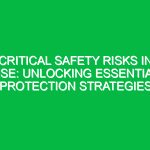In any workplace or Environment where Hazards exist, safety warning signs play a critical role in ensuring health, safety, and environmental (HSE) protection. These signs are not mere decorations; they serve as vital communication tools that inform employees and visitors about potential dangers, guiding them to take necessary Precautions. By understanding the significance and types of Safety warning signs, organizations can create a safer working atmosphere and promote a culture of Safety.
Understanding Safety Warning Signs
Safety warning signs are visual indicators designed to convey information about Hazards or unsafe conditions. They are essential in preventing accidents, injuries, and environmental harm. These signs typically incorporate standardized symbols and colors to ensure that they are easily recognizable and understood, regardless of language barriers. The primary purpose of these signs is to alert individuals to potential risks and to encourage safe behaviors.
Types of safety warning signs include:
- Warning Signs: Indicate a potential hazard that may cause injury or damage.
- Caution Signs: Suggest the presence of a less severe hazard that requires attention.
- Mandatory Signs: Instruct individuals to take specific actions to ensure safety.
- Prohibition Signs: Indicate actions that are not permitted in a specific area.
- Emergency Signs: Provide information on emergency exits, first aid stations, and other critical safety resources.
The Importance of Safety Warning Signs in HSE
Implementing effective safety warning signs is crucial for several reasons:
- Risk Reduction: Clear and visible signs help reduce the risk of accidents by alerting individuals to potential dangers.
- Compliance: Adhering to safety Regulations often requires the presence of specific warning signs, ensuring organizations avoid legal repercussions.
- Training and Awareness: Safety signs serve as a constant reminder of safety protocols, reinforcing Training and awareness among employees.
- Emergency Preparedness: Signs that indicate emergency exits and Procedures are vital for ensuring quick and safe evacuations during crises.
Key Components of Effective Safety Warning Signs
To maximize their effectiveness, safety warning signs should incorporate key components that enhance their visibility and clarity:
- Clear Symbols: Use universally recognized symbols that convey the message quickly and effectively.
- Contrasting Colors: Opt for high-contrast color schemes to ensure signs are easily visible in various lighting conditions.
- Simple Language: Use concise language that is easy to understand, avoiding complex jargon.
- Proper Placement: Position signs where they are most needed and likely to be seen, ensuring they are not obstructed.
- Regular Maintenance: Inspect signs regularly to ensure they remain visible and legible, replacing any that are damaged or faded.
Potential Hazards and Risks Related to Safety Warning Signs
While safety warning signs are designed to mitigate risks, there are instances where their effectiveness may be compromised. Some potential hazards related to safety warning signs include:
- Inadequate Training: If employees are not trained to recognize and respond to safety signs, their purpose is undermined.
- Sign Obstruction: Signs that are blocked by equipment, foliage, or other objects lose their visibility and effectiveness.
- Misinterpretation: Poorly designed or unclear signs can lead to confusion, resulting in unsafe behaviors.
- Environmental Factors: Weather conditions, such as rain or snow, can obscure signs, making them less effective.
Best Practices for Implementing Safety Warning Signs
To enhance the effectiveness of safety warning signs in the workplace, organizations should consider several Best Practices:
- Conduct Hazard Assessments: Regularly evaluate the workplace to identify hazards and determine the appropriate signs needed.
- Involve Employees: Engage employees in discussions about safety signs, as they can provide valuable insights based on their experiences.
- Utilize Technology: Explore digital signage options that can be updated in real-time to reflect changing hazards and conditions.
- Regular Training Sessions: Offer ongoing training that emphasizes the importance of recognizing and adhering to safety warning signs.
- Feedback Mechanism: Implement a system for employees to report issues related to safety signs, such as visibility problems or unclear messaging.
Real-Life Examples of Effective Safety Warning Signs
Examining real-life examples can provide valuable insights into how safety warning signs can be effectively utilized:
In a manufacturing facility, a comprehensive safety signage program was implemented following a series of minor accidents. The management conducted a hazard assessment and identified areas needing improvement. They replaced old signs with bright, new warning signs that clearly indicated potential hazards like machinery Operation, chemical exposure, and slip hazards. Employees were trained on the importance of recognizing these signs, resulting in a significant reduction in accidents. Over six months, the facility reported a 40% decrease in incident reports, demonstrating the impact of effective safety warning signs.
Another case occurred in a large construction project where workers often moved between different sites. The project managers knew that consistency in safety signage was critical. They adopted a standardized system of signs across all locations, ensuring that every worker recognized the signs, regardless of where they were working. This approach not only reinforced the safety culture but also improved communication among diverse teams.
Regulations and Standards Governing Safety Warning Signs
Various regulations and standards govern the use of safety warning signs in workplaces. In the United States, the Occupational Safety and Health Administration (OSHA) establishes guidelines for safety signs to ensure their effectiveness. osha‘s standards outline requirements for the design, placement, and maintenance of warning signs, mandating that they be used in areas where hazards are present.
Additionally, the American National Standards Institute (ANSI) provides guidelines that govern the design and use of safety signs. These standards help ensure that signs are consistent, recognizable, and effective in conveying information about hazards. Compliance with these regulations not only enhances Workplace Safety but also protects organizations from legal liabilities.
Conclusion
In conclusion, safety warning signs are indispensable elements of a secure HSE environment. By effectively communicating hazards and promoting safe behaviors, these signs play a pivotal role in preventing accidents and ensuring compliance with safety regulations. Organizations must prioritize the implementation of clear, visible, and well-maintained safety warning signs to foster a culture of safety.
As we have explored, the impact of safety warning signs extends beyond mere compliance; they contribute to a proactive approach to health, safety, and environmental Sustainability. By regularly assessing hazards, involving employees, and adhering to regulations, organizations can create a safer workplace for everyone. Remember, safety is a shared responsibility, and effective signage is a vital part of that equation.


